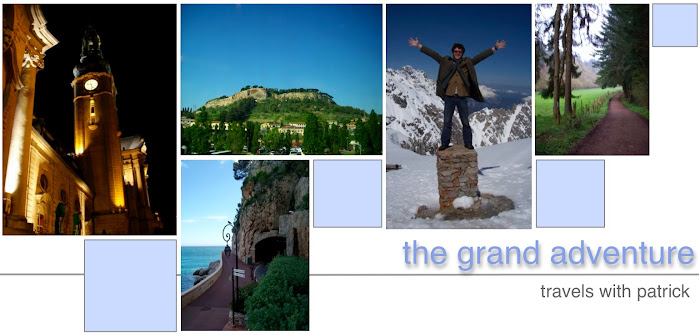It's 6:00 in the morning in Guilin, a small city in the south of China. The heat of the tropics has already begun to weave its way in between the concrete and tile edifices that line the lakefront. We're here to see a landscape that for over 2000 years has been been acclaimed as being the most beautiful in China. Eons ago, titanic forces thrust up a massive plateau of limestone above the countryside. Limestone - despite its strength - has the curious property of dissolving in rainwater. And so, for thousands of years, water following the path of least resistance dissolved away much of the plateau. Left behind are a stunning series of limestone columns, abutting the slow-flowing Li River. Immortalized in Classical Chinese paintings, these mountainous columns are China's greatest natural landmark.
Getting to this scene of natural splendor took some doing. First we had to find our train. This was accomplished with little to no effort, because our train was easily seven and a half miles long. Powered by electricity (quite possibly from an on-board nuclear reactor) the behemoth stretched on as far as the eye could see. This made finding our carriage somewhat tricky. It didn't help that we had no idea which carriage we were looking for (the carriage number being cleverly disguised amidst a sea of other numbers). The tactic my father employed was equally brilliant and repetitive: we handed our tickets to one of the conductor, and she directed us farther down the train. Reaching the next conductor, we were again directed farther down. A third conductor, a fourth, farther down, farther down. We repeated this procedure at least a dozen times before my father finally got fed up and skipped a conductor. Reaching the next conductor, we were - of course - comically pointed back the way we came. The only carriage we skipped was our own.
At our carriage at last.
By the time we got on board the train was nearly ready to depart. We were staying in a "Soft Sleeper" compartment, distinguished from a "Hard Sleeper" compartment less by the comfortability of the beds as by the presence of doors. Hard Sleepers have 4, 6, or 8 bunks in a compartment, and no door. Soft Sleepers have four bunks, a door, and a fancy carpet lining the carriage hallway. Our compartment was already occupied by the two other people who would be riding with us: a man (I will refer to him as Snore-Master for reasons that will soon become obvious) and a women (who gets no nickname, as she rarely interacted with us).
Snore-Master spoke some English, and we would later learn that he was a retired Medical Teacher. The women was already up in the top bunk, where she would remain for most of the voyage. We exchanged pleasantries, and I began taking bad pictures out of the grimy windows. Less than an hour into the trip, and despite it being only 5:30 in the afternoon, Snore-Master and the women were already lying down to sleep. Within minutes, Snore-Master had earned his nickname. My father - a veteran of many fishing trips, scout camps, and other large congregations of men snoring - had never heard Snore-Master's equal. Over the next sixteen hours (sixteen!) we were treated to a symphony of respiratory excretions. Snore-Master preformed everything: the classic quite nostril murmuring that rises into a rumbling chortle; breathy inhales followed by exhaled whistles of "seew"; slurping sounds reminiscent of the rudest consumption of soup; and his piece de resistonce: a thunderous inhaled snort followed by a measured fluttering exhale that so perfectly channeled the Three Stooges as to defy belief.
Suffice to say: we did not sleep well. The women would chime in every once in a while, but she was a novice, a mere amateur compared with Snore-Master. Here efforts did little more than demonstrate how hopelessly outclassed she was by the prodigy in the bunk beneath her. My father and I finally gave up our hopeless dreams of sleep around 5:00 in the morning, and spent the pre-dawn hours in the hallway. When Snore-Master finally woke up at 9:30 in the morning, we were all expecting to arrive in Guilin shortly. The train was scheduled to arrive at 11:30, and Snore-Master went to check if we were on schedule. When he returned, he angrily announced that the train was late, and promptly returned to his natural state of noisy unconsciousness.
The countryside whizzing by.
While the countryside was interesting, by 12:30 we were anxious to depart, and by 2:30 we were seriously considering jumping off. Ultimately, the train arrived at Guilin at 3:30 in the afternoon, nearly 24 hours since we had first set off from Shanghai. Soon we were in a cab, speeding into town. Our driver quickly found our hotel, where we checked in, dropped our bags, and appreciated that for the first time 24 hours, we were not moving.
Showering and changing, I consulted the internet to find a place for dinner. We were directed to an Indian restaurant - the highest rated restaurant in Guilin, and only five minutes from our hotel. After a false start, we found the restaurant, ate a terrific meal, returned to our hotel, and - finally - got some sleep.
Now it's time to head off toward the storied limestone hills that brought us here. If nothing else, our experiences getting here will serve as a benchmark against which no other ordeal will soon compare. And I am confidant that this town and its landscapes will be more than worth the effort. Let's see...



No comments:
Post a Comment